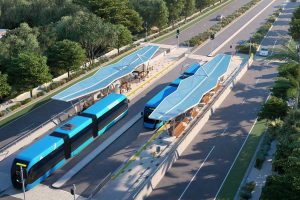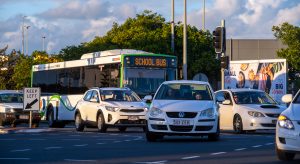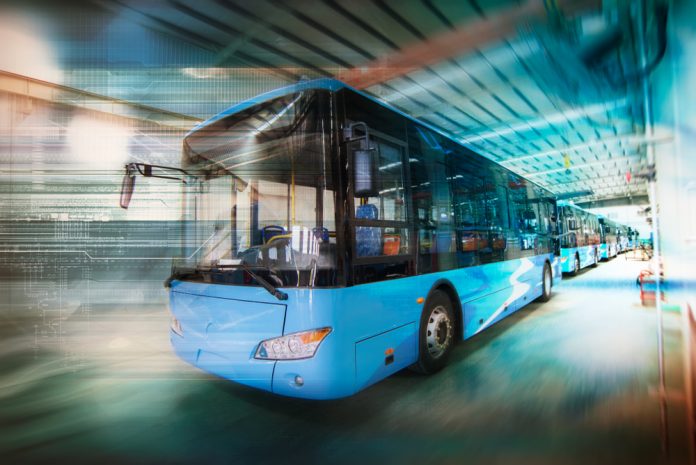Why can’t we just have more buses?
This Frequently Asked Question appears in the Sunshine Coast Mass Transit – Project Update dated 29 September 2021 and is answered along the lines “… around the world, a bus public transport system on its own does not provide the most effective service …”
Around the world, growing cities suffer ever-rising traffic congestion, a product of high car use.
And hopefully, transport options for the Sunshine Coast will embrace this deceptively good question because buses can, by design, provide a sustainable, whole-of-city road and transport solution.
Cities usually give priority to major road and transport infrastructure, like new motorways, heavy-rail, light-rail or “rapid bus transit” (bus rights-of-way).

Bus service upgrades and walking and cycling get less attention, less priority and much less funding. Cities may also limit urban sprawl, clustering residential, employment, educational, recreational and other land-uses closer together, mainly in and around central hubs and along associated corridors.
There are opposing dynamics. Building more roads stimulates car demand. New public transport infrastructure is so costly as to be self-limiting, mostly serving inner areas.
As well, constructing new infrastructure and curbing urban sprawl are long-term options, more about “city building”, with no guarantees of better overall travel outcomes eventuating, sooner or later.
What is clear is that travel delays per person are lower in smaller cities rather than larger.
Delays are also lower in cities with more public transport services than in cities of similar size with less public transport. So, an ideal solution would boost public transport widely and quickly.
Help keep independent and fair Sunshine Coast news coming by subscribing to our free daily news feed. All it requires is your name and email. See SUBSCRIBE at the top of this article
In Australia’s largest cities, public transport dominates in and around the central hubs. But of all the travel throughout these cities (in person-kilometres), roughly 80 per cent is by car, 15 per cent public transport, and 5 per cent other modes, including walk and cycle. Across smaller cities, the car share exceeds 90 per cent.
Buses account for less than 1 per cent of all road-vehicle-kilometres travelled across our cities, highlighting a game-changing opportunity, to save road space, increase road productivity, enable many more people to leave their cars behind, and trigger a traffic-shrinking effect.
The Sydney 2000 Olympics (albeit short-lived) demonstrated this effect.
Sydney focused on getting the best out of its existing road and transport infrastructure. Thousands of buses were hired from other towns and cities, widely boosting public transport capacity and helping to reduce traffic congestion, while more people than ever travelled across Sydney during that time.
Many questioned “Please, can this be done all the time?” Regrettably it wasn’t.
The point is any city can permanently replicate the traffic-shrinking effect by design, and readily increase public transport capacity at an affordable cost, with a remastered bus network, by comprehensively increasing bus fleets, and then:
- Raising service levels on existing bus routes; and
- Ensuring that all business centres and busy corridors are well served by buses, with high-frequency services; and
- Overlaying a set of cross-city bus routes (crisscrossing the whole urban area), operating on the main road system, with limited-stops, frequent, and interconnected services, to create an easy-to-understand express bus system.
Cross-city buses are vital, to deliver a decentralised, main road-based service layout, with high-quality services, and to provide a widely available alternative to using cars so much.

New bus-stops and bus-stopping bays can be built off-lane where practical, to keep through-traffic flowing past the bus-stops. Generally, the traffic-shrinking effect would negate the need for new bus-only lanes or other major infrastructure, while the bus sector (including bus manufacturing, operations, and maintenance) would be invigorated.
New or expanded bus depots would be required. Zero-emissions bus fuelling is on the way to being adopted, using energy derived from renewable sources.
All this is doable and is a positive way to increase road productivity, whereas current approaches, opting for combinations of major infrastructure projects, have failed over and over to reverse persistently rising car dependence and traffic congestion.
Firstly, a concept development phase is needed, to include designing new bus routes, quantifying bus service level upgrades, surveying demand for mode-shifting, estimating costs, modelling traffic-effects, preparing public communications plans, and consulting with industry and community.
Prioritising walking and cycling schemes further improves sustainability.
To make the transition, business cases need to compare the remastered bus network option with the major infrastructure options, on sustainability, value for money, and other economic, social and environmental criteria, and prioritise the projects accordingly.
Once the focus is about optimising existing road operations to ease traffic congestion, then major infrastructure questions can come later, including whether the best project for the Sunshine Coast in the long term may be the North Coast Rail Line upgrade or Beerwah-Airport rail line.
Allotting top-priority to a costly down-town light-rail (or similar) scheme is also questionable, given probable community and investor interest in getting the most out of the road system first and in choosing surer ways of reducing traffic congestion sooner rather than later.
The 2032 Olympics provides an ideal window to showcase reduced traffic congestion, before, during and after the Games, raising the prospect of other cities following suit and taking Sydney’s Olympic transport success one step further, into the realm of more liveable cities, all the time.
John Morandini (BEng-Hons UNSW 1971, MBA UNSW 1974) is a transport advocate and retired civil engineer, who worked over 40 years in NSW Government agencies and Ministerial offices, including in leading roles on road and transport policies, plans and operations, and on the Sydney Olympics.





